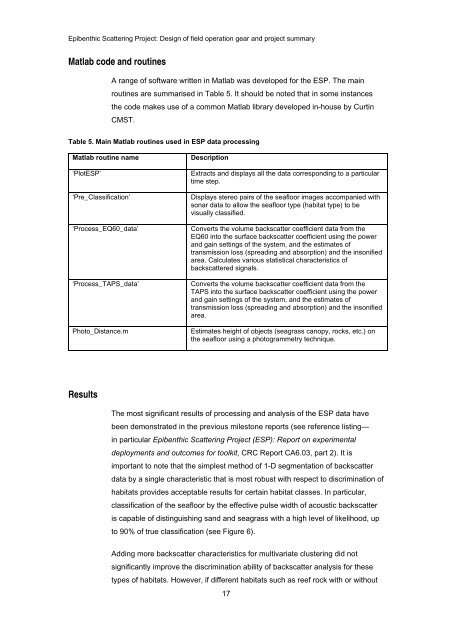Epibenthic scattering project - FTP Directory Listing
Epibenthic scattering project - FTP Directory Listing
Epibenthic scattering project - FTP Directory Listing
You also want an ePaper? Increase the reach of your titles
YUMPU automatically turns print PDFs into web optimized ePapers that Google loves.
<strong>Epibenthic</strong> Scattering Project: Design of field operation gear and <strong>project</strong> summary<br />
Matlab code and routines<br />
A range of software written in Matlab was developed for the ESP. The main<br />
routines are summarised in Table 5. It should be noted that in some instances<br />
the code makes use of a common Matlab library developed in-house by Curtin<br />
CMST.<br />
Table 5. Main Matlab routines used in ESP data processing<br />
Matlab routine name Description<br />
‘PlotESP’ Extracts and displays all the data corresponding to a particular<br />
time step.<br />
‘Pre_Classification’ Displays stereo pairs of the seafloor images accompanied with<br />
sonar data to allow the seafloor type (habitat type) to be<br />
visually classified.<br />
‘Process_EQ60_data’ Converts the volume backscatter coefficient data from the<br />
EQ60 into the surface backscatter coefficient using the power<br />
and gain settings of the system, and the estimates of<br />
transmission loss (spreading and absorption) and the insonified<br />
area. Calculates various statistical characteristics of<br />
backscattered signals.<br />
‘Process_TAPS_data’ Converts the volume backscatter coefficient data from the<br />
TAPS into the surface backscatter coefficient using the power<br />
and gain settings of the system, and the estimates of<br />
transmission loss (spreading and absorption) and the insonified<br />
area.<br />
Photo_Distance.m Estimates height of objects (seagrass canopy, rocks, etc.) on<br />
the seafloor using a photogrammetry technique.<br />
Results<br />
The most significant results of processing and analysis of the ESP data have<br />
been demonstrated in the previous milestone reports (see reference listing—<br />
in particular <strong>Epibenthic</strong> Scattering Project (ESP): Report on experimental<br />
deployments and outcomes for toolkit, CRC Report CA6.03, part 2). It is<br />
important to note that the simplest method of 1-D segmentation of backscatter<br />
data by a single characteristic that is most robust with respect to discrimination of<br />
habitats provides acceptable results for certain habitat classes. In particular,<br />
classification of the seafloor by the effective pulse width of acoustic backscatter<br />
is capable of distinguishing sand and seagrass with a high level of likelihood, up<br />
to 90% of true classification (see Figure 6).<br />
Adding more backscatter characteristics for multivariate clustering did not<br />
significantly improve the discrimination ability of backscatter analysis for these<br />
types of habitats. However, if different habitats such as reef rock with or without<br />
17


